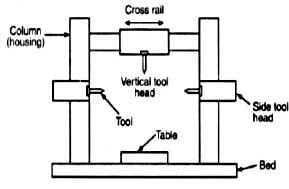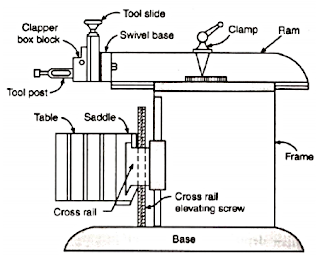MILLING MACHINE
Milling
is the cutting operation that removes metal by feeding the work against a
rotating, cutter having single or multiple cutting edges. Flat or curved
surfaces of many shapes can be machined by milling with good finish and
accuracy. A milling machine may also be used for drilling, slotting, making a
circular profile and gear cutting by having suitable attachments.
Working Principle:
The workpiece is holding on the worktable of the machine. The table movement
controls the feed of workpiece against the rotating cutter. The cutter is
mounted on a spindle or arbor and revolves at high speed. Except for rotation
the cutter has no other motion. As the workpiece advances, the cutter teeth
remove the metal from the surface of workpiece and the desired shape is
produced.
Horizontal Milling Machine
Construction
The main part of machine is base, Column,
Knee, Saddle, Table, Overarm, Arbor Support and Elevating Screw.
1. Base:
It gives support and rigidity to the machine and also acts as a reservoir for
the cutting fluids.
2. Column:
The column is the main supporting frame mounted vertically on the base. The
column is box shaped, heavily ribbed inside and houses all the driving
mechanisms for the spindle and table feed.
3. Knee:
The knee is a rigid casting mounted on the front face of the column. The knee
moves vertically along the guide ways and this movement enables to adjust the
distance between the cutter and the job mounted on the table. The adjustment is
obtained manually or automatically by operating the elevating screw provided
below the knee.
4. Saddle:
The saddle rests on the knee and constitutes the intermediate part between the
knee and the table. The saddle moves transversely, i.e., crosswise (in or out)
on guide ways provided on the knee.
5. Table:
The table rests on guide ways in the saddle and provides support to the work.
The table is made of cast iron, its top surface is accurately machined and
carriers T-slots which accommodate the clamping bolt for fixing the work. The
worktable and hence the job fitted on it is given motions in three directions:
a).
Vertical (up and down) movement provided by raising or lowering the knee.
b).
Cross (in or out) or transverse motion provided by moving the saddle in
relation to knee.
c).
Longitudinal (back and forth) motion provided by hand wheel fitted on the side
of feed screw.
In
addition to the above motions, the table of a universal milling machine can be
swiveled 45° to either side of the centre line and thus fed at an angle to the
spindle.
6. Overarm:
The Overarm is mounted at the top of the column and is guided in perfect
alignment by the machined surfaces. The Overarm is the support for the arbor.
7. Arbor support:
The arbor support is fitted to the Overarm and can be clamped at any location
on the Overarm. Its function is to align and support various arbors. The arbor
is a machined shaft that holds and drives the cutters.
8. Elevating screw:
The upward and downward movement to the knee and the table is given by the
elevating screw that is operated by hand or an automatic feed. Operations
performed on a milling machine are:
1. Plain
or slab milling: Machining of a flat surface which is parallel to the axis of
the rotating cutter.
2. Face milling:
Machining of a flat surface which is at right angles to the axis of the
rotating cutter.
3. Angular milling:
Machining of a flat surface at an angle, other than a right angle, to the axis
of revolving cutter.
4. Straddle milling:
Simultaneous machining of two parallel vertical faces of the work-pieces by a
pair of side milling cutters.
5. Form
milling: Machining of surfaces which are of irregular shape. The teeth of the
form milling cutter have a shape which corresponds to the profile of the
surface to be produced.
6. Gang
milling: Simultaneous machining of a number of flat horizontal and vertical
surfaces of a workpiece by using a combination of more than two cutters mounted
on a common arbor.





































